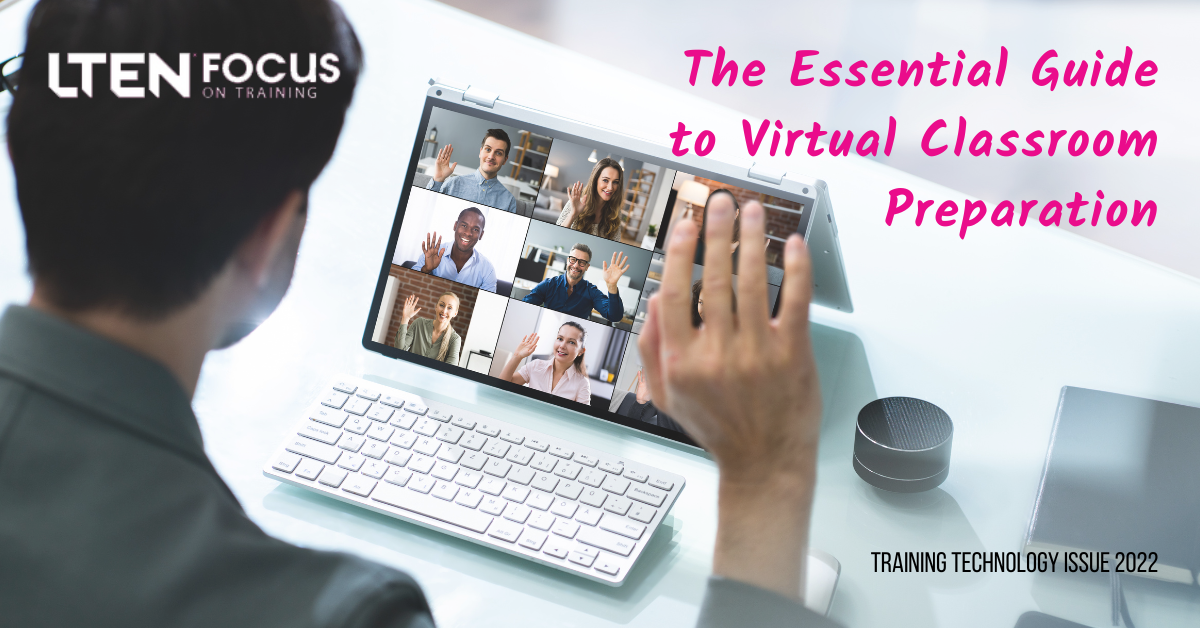
VIRTUAL TRAINING – Cindy Huggett, CPTD
Preparation makes the difference between success and failure
 Laptop, check. Webcam, check. You’re all set to facilitate your virtual class, right? Many virtual trainers would think so, but several important pieces of the puzzle are missing from this list. The best virtual classes run smoothly because of careful preparation. If your setup doesn’t include planning for contingencies, then you haven’t fully set up for success.
Laptop, check. Webcam, check. You’re all set to facilitate your virtual class, right? Many virtual trainers would think so, but several important pieces of the puzzle are missing from this list. The best virtual classes run smoothly because of careful preparation. If your setup doesn’t include planning for contingencies, then you haven’t fully set up for success.
The emphasis you place on advance preparation can be the difference between success and failure in a virtual class.
Planning for Virtual
All facilitators typically prepare for a training class by planning content, anticipating questions and researching background information on the audience. Virtual facilitators take even more steps to get ready, such as setting up the virtual classroom activities (polls, whiteboards, etc.), having a glass of water nearby and doing vocal warmups to avoid a scratchy voice.
To truly prepare for a seamless virtual learning experience, it’s important to do more.
The best virtual facilitators place special emphasis on their preparation. They do many seemingly simple things that make a huge difference in the quality of the learning experience. These extra steps can keep a virtual class moving forward during any type of technical difficulty.
The Virtual Checklist
I have personally facilitated thousands of virtual classes over the past 20 years and have coached hundreds of virtual facilitators along the way. Based on my experience, this is the “extra-prepared” technology preparation checklist that I recommend.
1. Laptop
The obvious requirement to facilitate virtual training is a laptop, desktop or other internet-connected device. Most facilitators will also have a second device logged into the virtual classroom so they can see the participant view. This second device also serves as a backup, in case the first one unexpectedly crashes. Ideally the second device is a laptop, but it can be a mobile phone or tablet if needed.
The extra steps that take the device setup to the next level are to:
-
- Ensure the virtual classroom software is the most current version.
- Have the battery fully charged in case of power outages.
- Have a third device available if needed, with the virtual classroom app already open with the connection details typed in.
2. Headset or External Microphone
The most important element of a seamless virtual class is crystal clear sound: each speaker clearly heard, without disruptive background noise. Facilitators may think their audio sounds fine when using a built in device microphone, but that’s rarely the case. Participants appreciate facilitators who take the time to enhance their audio connections using noise-canceling features.
-
- The extra steps that take an audio setup to the next level are to:
- Use a wired connection for audio devices, both for best quality and to avoid any potential Bluetooth disruptions.
- Test various microphone positions to eliminate extraneous sounds (like heavy breathing or paper shuffling).
- Run the platform’s audio test before each and every virtual class.
3. Webcam
While most modern laptops have built-in webcams, I highly recommend using an external camera that can be properly positioned. A camera should be set at eye level so that the video feels conversational. It should also have proper lighting, or the facilitator might be difficult to see. These small adjustments make a big difference in the video quality, but unfortunately they are often overlooked.
The extra steps that take a video setup to the next level are to:
-
- Adjust the platform’s video settings for clarity and quality.
- Use external camera software to fine-tune features like backgrounds,overlays, sizing and other enhancements.
- Avoid video fatigue by adopting features like “hide self-view.”
4. Solid Internet Connection
The higher the bandwidth, the faster the connectivity and the better the learning experience. It’s a common assumption that internet bandwidth will be problematic during virtual classes, and nothing can be done about it.
However, there are many simple steps that can be taken in advance by facilitators and participants alike to increase internet speed. For example, using wired connections (vs. Wi-Fi) will prioritize the device on the network. And closing out of any other programs that are also using the internet (such as cloud file syncing services) will help increase bandwidth availability for the virtual classroom.
The extra steps that take connectivity to the next level are to:
-
- Position the router for highest available speeds (i.e., at the highest point in the building and away from other electronic devices).
- Find out if your internet provider allows an admin to prioritize certain devices on your network, and if so, use it.
- Have an internet backup plan ready to use such as a mobile device “hotspot.”
Conclusion
Most tech disasters can be avoided or mitigated through the facilitator’s advance planning. By taking the time to carefully consider the setup and plan for contingencies, you can prevent most issues from happening in the first place and be easily equipped to handle them when they do.
Cindy Huggett, CPTD, is a consultant and author whose books include The Facilitator’s Guide to Immersive, Blended and Hybrid Learning and Virtual Training Tools and Templates. Email her at
Cindy@CindyHuggett.com.








